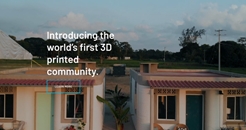 The world’s first 3D-printed neighbourhood
The world’s first 3D-printed neighbourhood
From an article by Fast Company
Following on from my blog In 2018 about a housing non-profit, New Story and construction technology firm, Icon debuting a 3D printed home in Austin, Texas with planning permission (permits), the world’s first 3D-printed neighbourhood now has its first houses.
New Story is focused on using 3D printing technology to house the homeless and a giant 3D printer is currently squeezing out new homes in rural Mexico. Each one costs a few thousand pounds, takes 24 hours and lets local families upgrade from a shack to a two-bedroom house. Could this be part of the global housing solution?
After printing, the 500-square-foot houses are finished with roofs, windows, and interiors. New Story, the nonprofit leading the project, believes that the new construction process could be part of the solution for affordable housing in some of the poorest communities in the world.
The nonprofit, founded five years ago to bring housing to people living in extreme poverty, has already built more than 2,700 homes in Haiti, El Salvador, Bolivia, and Mexico, using traditional construction. However, it recognized that new technology could help it continue to work faster and decrease costs. Two years ago, it partnered with Icon, a construction tech company based in Austin, to begin developing a 3D printer rugged enough to work even in the most challenging conditions.
The new Mexican neighborhood, which will have 50 of the homes, will be the first community to use this type of technology at scale. The team initially planned to build in another part of Mexico, but because of delays in the process of working with the government to get the land, decided to start further south in Tabasco, a state that borders Guatemala; the new location faces a higher risk of earthquakes, so the design went through even more structural engineering tests.
The printer works by squirting a concrete mixture in layers to build floors and walls. Software monitors the weather conditions, and the machine can adjust the mixture. The team can use an app to make slight adjustments to the blueprint on site, but the printing process is essentially autonomous.
New Story has partnered with a local nonprofit, Echale a Tu Casa, to finish the parts of the homes that can’t be 3D-printed e.g. windows, roof, etc., providing jobs to local construction workers.
The finished houses have two bedrooms, a living room, a kitchen, and a bath—a vast difference from the simple shacks common in the area. The families who will live in the homes earn a median income of $76.50 a month. For a majority of the families, this is the first time ever that they will have indoor restrooms and plumbing and sanitation.
The nonprofit partnered with the local government—which is providing both the land and infrastructure like new roads and electricity—to identify the 50 families in the area in the greatest need. Once New Story finishes printing the homes, the new residents own them outright.
The same technology could also help transform the construction of affordable housing in the United States. Earlier this year, Icon printed a welcome center for a master-planned community in Austin, Texas, designed for people who have been chronically homeless, and the company is beginning to print 400-square-foot homes in the community that will be completed in early 2020.
The company plans to continue to print additional homes and develop the technology. In Latin America, New Story already has interest from multiple other governments that want to donate land to build similar communities, many of which have already visited the new site in Mexico.
See more on the New Story site.
Retweet about this article:
From an article by Fast Company, 22/01/2020